You’re absolutely right — Lincoln Wheat pennies are a staple in the numismatic world, and the 1926 series is no exception. Even though these coins had high mintages, their age, historical value, and variations in condition make them quite collectible.
Here’s a clear value breakdown of the 1926 Lincoln Wheat pennies based on mint location and condition:
1926 Wheat Penny Value Chart
| Condition | 1926 (No Mint Mark) | 1926-D (Denver) | 1926-S (San Francisco) |
|---|---|---|---|
| Good (G-4) | $0.29 | $1.82 | $12 |
| Very Good (VG-8) | $0.35 | $2.12 | $15 |
| Fine (F-12) | $0.47 | $4.12 | $18 |
| Very Fine (VF-20) | $0.59 | $9.06 | $24 |
| Extra Fine (EF-40) | $2.41 | $18 | $54 |
| About Uncirculated (AU-50) | $6.05 | $41 | $88 |
| Mint State 60 (MS60) | $12 | $149 | $260 |
| Mint State 63 (MS63) | $14 | $200 | $592 |
History of the 1926 Wheat Penny
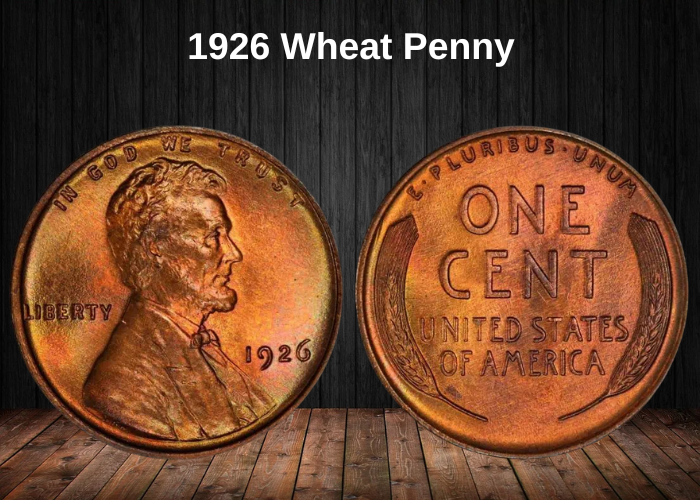
Origins of the American Penny
The first American pennies were minted in 1787, and they officially became the lowest denomination in U.S. coinage following the abolition of the half-cent in 1857. A major milestone came in 1909 with the introduction of the Lincoln penny — the first U.S. coin to feature a real historical figure.
The design was the work of Victor David Brenner, commissioned as part of President Theodore Roosevelt’s initiative to beautify American coinage. The year 1909 also marked the centennial of Abraham Lincoln’s birth, making it a fitting moment for such a symbolic change.
1926 Wheat Penny Types & Mintages
| Mint Location | Coin Type | Mintage |
|---|---|---|
| Philadelphia | 1926 (no mint mark) | 157,088,000 |
| San Francisco | 1926-S | 4,550,000 |
| Denver | 1926-D | 28,020,000 |
| Total | — | 185,658,000 |
The obverse (front) of the coin features Lincoln’s portrait, which was inspired by a sculpture by Augustus Saint-Gaudens.
As for the reverse, Brenner originally proposed a design framed with tree branches, but it was rejected by the Mint Director for being too European in style. He then replaced them with stylized wheat stalks, giving rise to what we now know as the “Wheat penny” — a truly American design.
Features of the 1926 Wheat Penny
The 1926 Wheat pennies belong to the long-running series of one-cent coins featuring Abraham Lincoln’s profile on the obverse. Designed by Victor David Brenner, these coins were introduced in 1909 to honor the 16th President of the United States, who was tragically assassinated.
Over the years, the reverse design, weight, and composition of the Lincoln penny have undergone several changes. Yet despite these updates, this iconic coin series remains in circulation today — a lasting tribute to Lincoln’s legacy.
The obverse of the 1926 Wheat Penny
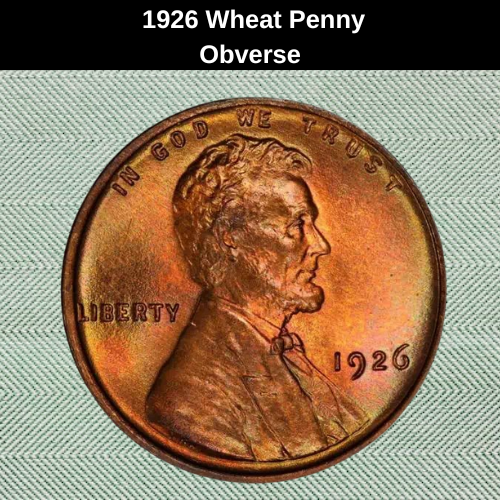
As the name suggests, the 1926 Lincoln penny features a portrait of Abraham Lincoln at the center of the obverse. The former president is shown facing right, with the date and mint mark (if present) appearing in front of him. To the left, you’ll see the word LIBERTY.
Since the designer’s initials were reinstated in 1918, you can also find “V.D.B.” just beneath Lincoln’s shoulder. Completing the design is the motto “IN GOD WE TRUST”, which arches above Lincoln’s head.
The reverse of the 1926 Wheat Penny
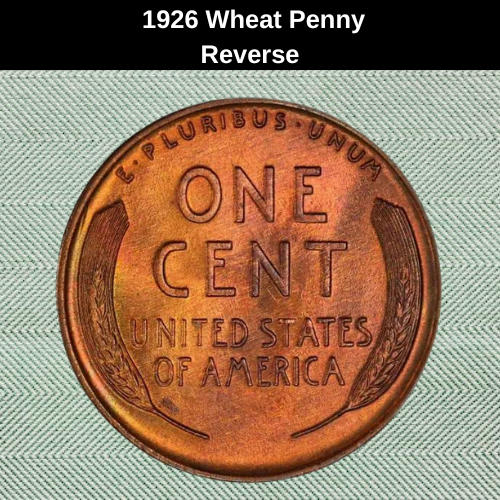
The reverse of the 1926 Wheat penny, like others in the series, has a very simple and recognizable design. It shows two wheat ears—one along the left edge and the other along the right—framing the text in the center. The central inscriptions are laid out in four lines and read: One Cent, United States of America.
Above this central text, you’ll see the Latin phrase E Pluribus Unum. This slogan, which means “Out of many, one,” is a legal requirement for all U.S. coins and symbolizes the unity of the states.
| 1926 Wheat Penny Details | |
| Face value | One cent ($0.01) |
| Coin diameter | 19.05 mm (1.75 inches) |
| Shape | Round |
| Compound | An alloy of 95% copper with the remainder zinc or tin |
| Coin thickness | 1 mm (0.03937 inches) |
| Coin weight | 3.11 g (0.10970 ounces) |
| Edge | Plain |
Other features of the 1926 Wheat Penny
The 1926 Wheat penny is a one-cent coin with a smooth (plain) edge. It’s made from a copper-based alloy that consists of 95% copper. Each coin weighs exactly 3.11 grams, which is about 0.1097 ounces. In terms of size, it has a diameter of 19.05 millimeters (or 0.75 inches) and a thickness of 1.52 millimeters (around 0.0598 inches).
1926 Wheat Penny Grading Guides
Because 1926 Wheat pennies are nearly 100 years old, the smartest move is to have your coin evaluated by a professional grading service. These experts can accurately assess the condition of your cent using the Sheldon grading scale.
Here’s a breakdown of that scale:
- Grade 1 – Basal State-1
- Grade 2 – Fair
- Grade 3 – Very Fair
- Grades 4, 5, 6 – Good
- Grades 7, 8, 10 – Very Good
- Grades 12, 15 – Fine
- Grades 20, 30 – Very Fine
- Grade 40 – Extremely Fine
- Grade 50 – About Uncirculated
- Grades 60, 65, 70 – Mint State
Be sure to consult our coin grading guides to determine where your coin falls on this scale — it’s an essential step in figuring out its true market value.
1926 Wheat Penny Value Guides
In 1926, a total of 185,658,000 Lincoln pennies were minted across three different U.S. Mint locations. Since there were no proof coins produced that year, all pennies from 1926 you come across are regular circulation strikes.
1926 No Mint Mark Wheat Penny Value
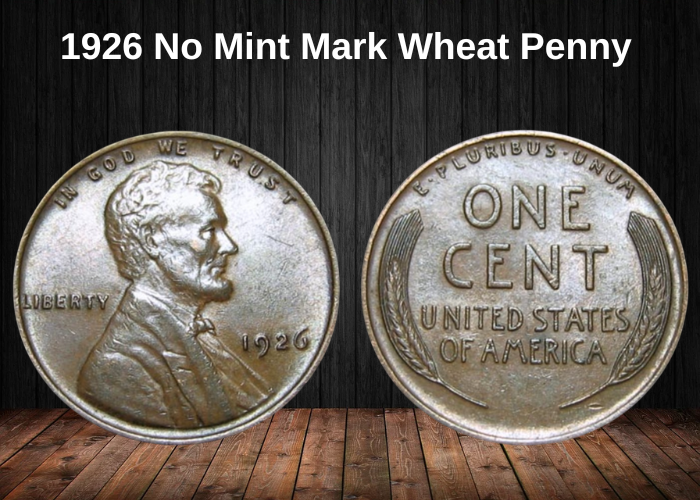
The 1926 Philadelphia Minted Lincoln pennies are still available for collectors, although not all of the 157,088,000 coins minted have survived the passage of time. The coins are available in three main variations based on their color, which significantly influences their value.
- Brown coins: Typically, these coins, which have spent time in circulation, are priced between $0.10 and $6. However, those in mint state can range from $6 to $24 depending on their grade. The highest auction record for this type is $408.
- Red-brown coins: These are more desirable and their prices generally fall between $9 and $45. The auction record for a red-brown 1926 penny is $2,300.
- Red coins: These are the most prized specimens. Their prices vary from $18 to $220, but coins in MS 67 condition can command much higher prices. The average price for red coins in MS 67 is around $1,300. However, in rare cases, they can go much higher, like the 1926 MS 63 red penny that sold for $7,475 at auction in 2010.
The color and condition of the penny greatly impact its market value, with red coins in mint condition generally being the most sought-after by collectors.
1926 D Wheat Penny Value
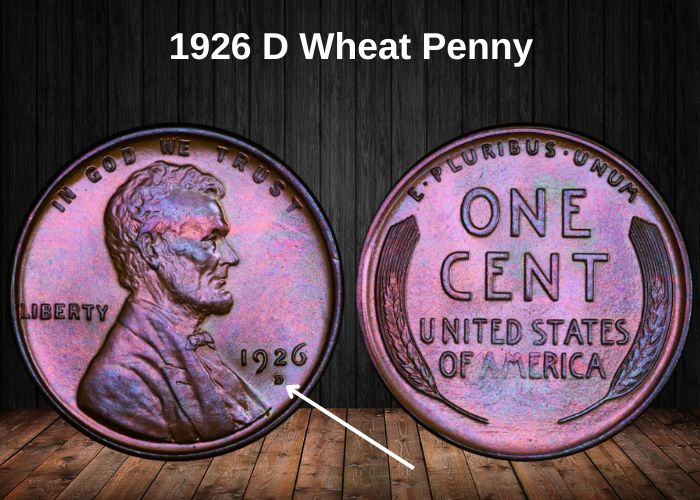
In 1926, the Denver Mint produced 28,020,000 Lincoln pennies, and these coins are marked with a “D” under the date. The value of these pennies varies depending on their color and condition:
- Brown pennies: Circulated brown coins are generally worth between $1 and $65. For those in mint state, prices can range from $85 to $600. The auction record for a brown 1926 D penny is $1,923.
- Red-brown pennies: These coins are more valuable, with prices typically ranging from $160 to $950 for coins graded between MS 62 and MS 65. The highest cost for a 1926 D red-brown penny is around $1,000 for an MS 65 RB coin.
- Red pennies: These are significantly more expensive, and their prices depend on their grade. The following are typical price ranges for red 1926 D pennies:
- MS 62: $250
- MS 63: $450
- MS 64: $825
- MS 65: $3,000
The value for a 1926 red penny in MS 66 grade is estimated at $16,500, but the highest auction price went to a rare specimen graded MS 66+ that sold for $38,400 in 2021.
The value of these coins is primarily influenced by their condition, with higher-grade red pennies commanding the most significant prices at auction.
1926 S Wheat Penny Value
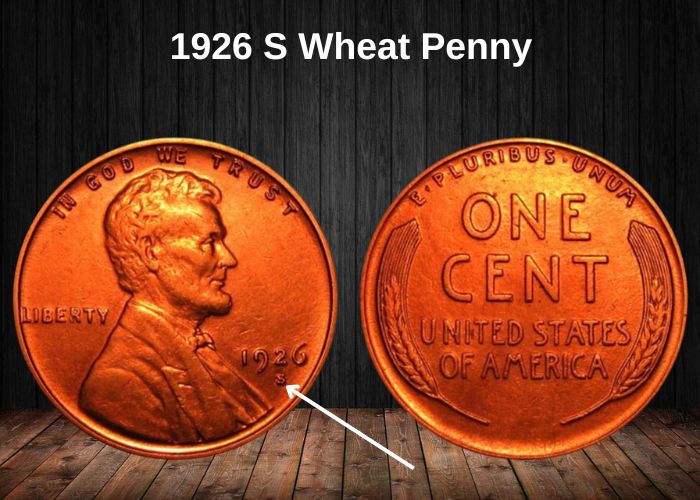
The 1926 S penny had the lowest mintage of the 1926 series, with only 4,550,000 coins struck at the San Francisco mint. This makes them semi-key coins in the Lincoln Wheat penny series, and they tend to be more expensive, especially in higher grades.
Here’s an overview of their value:
- Brown specimens: Circulated brown 1926 S pennies range in price from $8 to $155. Those in mint state have higher prices, with typical prices falling within the following ranges:
- MS 60: $235
- MS 61: $275
- MS 62: $450
- MS 63: $700
- MS 64: $950
- MS 65: $2,400
- Red-brown pennies: The 1926 S red-brown coins are quite collectible and more expensive, with prices starting at $450 for circulated specimens. Here are the values for better-graded red-brown coins:
- MS 63: $950
- MS 64: $1,500
- MS 65: $14,000
- Red pennies: Red 1926 S pennies are very rare and highly sought after. In 2006, an MS 65 red penny set an auction record, selling for $149,500. This price highlights how valuable these coins are in exceptional condition.
Overall, the 1926 S pennies, especially those in red and higher grades, are among the most valuable coins in the Wheat series due to their low mintage and scarcity.
Rare 1926 Wheat Penny Errors List
The 1926 penny set offers collectors an exciting opportunity to find error coins, which can add significant value and uniqueness to any collection. Although most errors are subtle and require a magnifying glass or microscope to detect, they can be very rewarding for those who enjoy the thrill of discovering them.
Clipped planchet
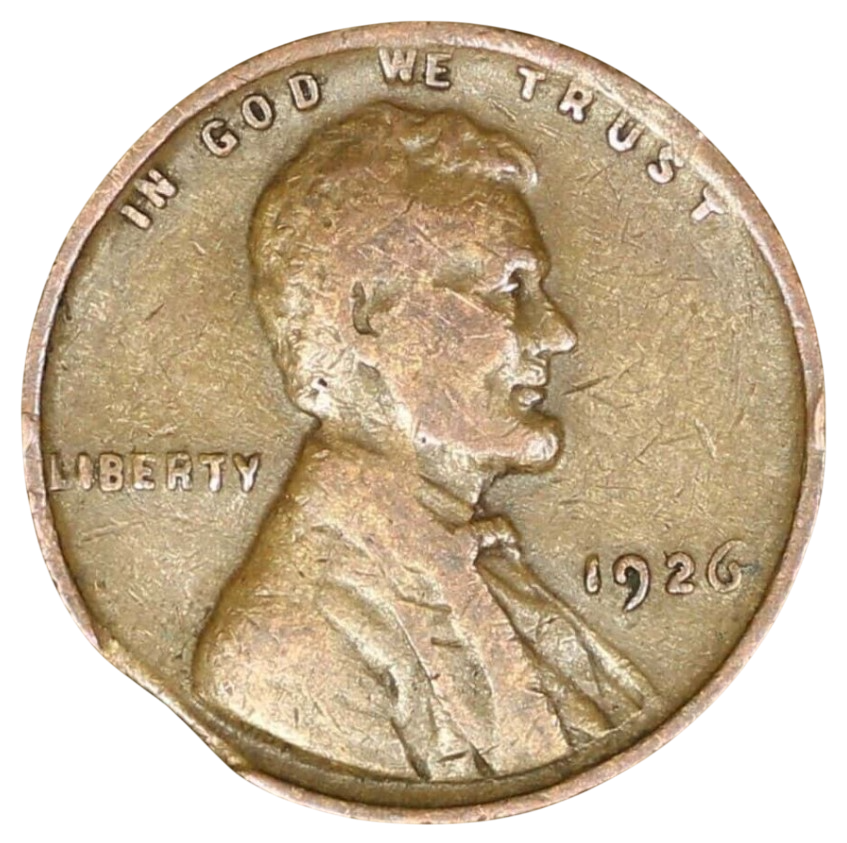
When irregularities occur during the minting process, they can result in a clipped planchet, which leads to coins with a missing piece at the edge. This minting error happens when part of the metal isn’t properly included during the planchet cutting process, creating an incomplete coin.
These types of errors are highly prized by collectors, as they make the coin unique and special. Clipped planchet coins tend to have much higher value than normal coins, and depending on the size of the clip and the coin’s condition, they can be worth several hundred dollars.
The value of a clipped coin increases based on several factors, such as:
- Clip size: The larger the missing piece, the more interesting the coin will be to collectors.
- Condition: Coins with a cleaner clip or those in good overall condition tend to be more valuable.
- Rarity: Some coins with more complex clips or less common defects may be even more valuable.
In summary, a clipped planchet is a defective and rare coin that can be a valuable find for collectors.
Doubled die obverse
The 1926 DDO (Double Die Obverse) pennies feature visible doubling on the image and/or inscriptions, which occurs when the die used to strike the coin shifts slightly, creating a second, slightly offset impression. A common area to find doubling is on Lincoln’s eyelid.
Coins with this error are quite valuable to collectors due to their rarity. A 1926 DDO penny with doubling on Lincoln’s eyelid typically has a price range of $75 to $150, depending on its condition and the clarity of the error. The more pronounced the doubling, the higher the value.
BIE error
The BIE error is a common flaw found in the Lincoln penny series, and the 1926 cent is no exception. This error occurs when a cracked die leaves an I-shaped line between the letters B and E in the word LIBERTY, making it appear as if there is an extra “I” in the word.
Although this error is relatively minor and fairly common, it can still be of interest to collectors. Most BIE error pennies are valued around $5, as they are not too rare. However, if the die crack is more pronounced and the line is clearly visible, especially on well-preserved coins, their value can increase, with the best examples reaching $15 or even more.
Off-center
Off-center error pennies are a popular type of mistake coin among collectors, as they often have a unique and unusual appearance. These errors occur when the coin’s planchet is not properly aligned with the die during striking, causing part of the design to be “off-center.”
For 1926 off-center error pennies, the value depends on the extent of the misalignment. Coins with a 10% off-center are typically worth around $25 to $50. However, if the misalignment is more dramatic, such as a 50% off-center error, the value can rise significantly, with such coins potentially worth a few hundred dollars. The more extreme the off-center, the rarer and more valuable the coin becomes.
Re-punched mint mark
The RPM (Repunched Mint Mark) error occurs when the mint mark is improperly struck during the first attempt and is then struck again in a slightly different position. This leads to a visible doubling or shift of the mint mark, creating a unique collectible error.
For 1926 pennies with the RPM error, which can occur on coins from the Philadelphia, Denver, or San Francisco mints, the value typically falls within the range of $7 to $15, depending on the clarity of the error and the condition of the coin. These coins are a popular find for collectors due to their unique characteristics, though they are generally more affordable compared to other types of error coins.
Broad strike
Coins that are struck without an adequately attached collar are known as broadstrikes. This occurs when the collar (which helps shape the coin during minting) doesn’t engage properly with the planchet, causing the coin to be struck wider and thinner than usual.
In the case of 1926 Wheat pennies, broadstrikes are relatively rare and desirable for collectors who specialize in error coins. Due to their unique appearance and the rarity of the error, broadstrike pennies can be worth up to $150, depending on their condition and the degree of the error. These coins can be an exciting addition to a collection, especially for those interested in minting mistakes.
Where to sell your penny?
Now that you know the value of your penny, you might be wondering where to sell it. Don’t worry: here’s a guide to some of the best online platforms where you can easily sell your coins, along with their advantages and disadvantages.
Discover the best platforms for selling coins online (pros and cons).
FAQ about the 1926 Pennies with the Wheat Reverse
Q1: What is a 1926 Wheat Penny?
A 1926 Wheat Penny is a one-cent coin issued by the United States in 1926 as part of the Wheat Cent series. It features the portrait of Abraham Lincoln on the obverse and two ears of wheat on the reverse. The coin was minted in three different mints: Philadelphia, Denver, and San Francisco.
Q2: How many 1926 Wheat Pennies were minted?
Here are the mintages for the 1926 Wheat Pennies:
- 1926 (Philadelphia): 168,130,000
- 1926 D (Denver): 22,080,000
- 1926 S (San Francisco): 2,150,000
The 1926 Philadelphia penny has the highest mintage, while the 1926 S is the rarest of the three varieties, making it more valuable.
Q3: What is the design of the 1926 Wheat Penny?
- Obverse: Features the portrait of Abraham Lincoln, designed by Victor David Brenner. The inscriptions include “IN GOD WE TRUST”, “LIBERTY”, and the year “1926”.
- Reverse: The reverse displays two ears of wheat, with “UNITED STATES OF AMERICA” at the top, “E PLURIBUS UNUM” at the bottom, and “ONE CENT” in the center.
Q4: What is the value of a 1926 Wheat Penny?
The value of the 1926 Wheat Penny varies depending on the mint mark and condition. Below are the approximate values:
- 1926 (Philadelphia):
- Good: $0.30
- Very Fine: $1.00
- Extremely Fine: $2.50
- Uncirculated: $7.00 – $12.00
- 1926 D (Denver):
- Good: $0.50
- Very Fine: $1.50
- Extremely Fine: $4.00
- Uncirculated: $12.00 – $25.00
- 1926 S (San Francisco):
- Good: $2.00
- Very Fine: $5.00
- Extremely Fine: $12.00
- Uncirculated: $30.00 – $80.00
Q5: Why is the 1926 S Wheat Penny more valuable than the 1926 Philadelphia and 1926 D?
The 1926 S is more valuable due to its low mintage of 2.15 million coins. This makes it significantly rarer than the 1926 Philadelphia penny, which has a mintage of 168 million, and the 1926 D penny with a mintage of 22 million. Because of its rarity, the 1926 S penny is highly sought after by collectors.
Q6: What is the significance of the Wheat design on the reverse?
The Wheat design on the reverse of the Wheat Penny features two stalks of wheat, which were meant to symbolize the country’s agricultural roots. The wheat symbolized prosperity and abundance, reflecting the importance of agriculture in early 20th-century America. The design was used on Lincoln Cents from 1909 to 1958 before being replaced with the Lincoln Memorial design in 1959.
Q7: What is the condition of my 1926 Wheat Penny?
The condition of your coin is important when determining its value. Common grades include:
- Good (G): The coin is heavily worn, but the date and major details are still visible.
- Very Fine (VF): The coin shows moderate wear, but details like Lincoln’s hair and the wheat heads are still visible.
- Extremely Fine (XF): Only light wear, with sharp details.
- Uncirculated (UNC): The coin has never been in circulation and has no signs of wear, showing a luster from minting.
Coins in higher grades like Uncirculated (MS) are worth more than those in lower grades.
Q8: How can I identify the mint mark on the 1926 Wheat Penny?
The mint mark on the 1926 Wheat Penny can be found on the obverse, just below Abraham Lincoln’s portrait. The mint marks are:
- No Mint Mark: This indicates the coin was minted at the Philadelphia Mint.
- D Mint Mark: This indicates the coin was minted at the Denver Mint.
- S Mint Mark: This indicates the coin was minted at the San Francisco Mint.
The mint mark is crucial when determining the rarity and value of the coin.
Q9: Are there any known errors with the 1926 Wheat Penny?
While the 1926 Wheat Penny is not known for major errors, collectors should watch out for the following:
- Weak Mint Marks: Some 1926 D or 1926 S pennies may exhibit weak mint marks due to worn dies, but these are not considered significant errors.
- Die Variations: There may be subtle die variations or differences in the placement of the mint mark, but these variations generally do not add significant value unless there is a strong collector demand.
Q10: How should I store and preserve my 1926 Wheat Penny?
To preserve your 1926 Wheat Penny and maintain its value:
- Use Coin Holders: Store your coins in 2×2 holders, slabbed cases, or coin capsules to protect them from dirt, moisture, and physical damage.
- Avoid Direct Contact: Handle your coins only with cotton gloves to avoid oils and dirt from your hands affecting the coin.
- Store in a Safe Place: Keep your coins in a dry, cool place, away from extreme temperatures and humidity. Coin safes or safe deposit boxes are ideal for long-term storage.
Q11: What is the historical significance of the 1926 Wheat Penny?
The 1926 Wheat Penny represents a key moment in U.S. history during the Roaring Twenties, a time of economic growth and cultural change. This coin is part of the Wheat Cent series, which ran from 1909 to 1958, and helped solidify Abraham Lincoln’s image as an enduring symbol of American unity and perseverance. The design features the iconic wheat reverse, which reflects America’s agricultural roots.
Q12: Is the 1926 Wheat Penny a good investment?
While the 1926 Wheat Penny is not as valuable as rarer key dates in the series, such as the 1909-S VDB or 1914-D, it can still be a good investment if you focus on high-quality 1926 S pennies. Coins in high grades or rare varieties are often sought after by collectors and can appreciate in value over time. As part of the popular Lincoln Cent series, it remains a collectible coin for numismatists.



















































